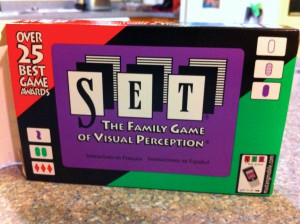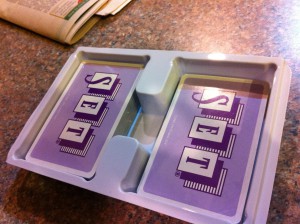Set: Card Games Can Be Usable Too

Set is an abstract card game that is more of a brainteaser than a “game”. Being a Mensa-recommended brainteaser, this means that it’s a bit complex to get your head around. Maybe not complex in the same way as Axis & Allies, but Set requires a lot of mental processing for the first time player.
In a nutshell, Set is a game about finding “sets” (see what they did there?) of matching symbols on its cards. The thing is, there are four different ways you can match the cards. It’s a lot for your brain to manage, especially when you’re racing other players who are doing the same thing.
And this is why it’s being featured here on thatgamesux.com: it is packaged in a way to help ease the player into fully understanding the game. There are lots of games that have different rules for first-time players - sometimes they eliminate certain parts of the game, or give the players extra resources, or something else to make it a little easier the first time around. Set eliminates one whole dimension of matching - so there’s only three different ways to match the cards. That makes a massive difference in getting the hang of the game.
Notice how the pack of cards on the left is bigger than the one on the right? That’s not an accident…
The best part is that the game comes with two different decks of cards, and for the first play, you just need to unwrap the smaller deck and use those cards. Brilliant! Ready for the full challenge? Unwrap the second deck and shuffle it in, you’re good to go. It’s a tiny thing, but it keeps players from having to sort through the cards and manually remove one type. More likely, without this touch, everybody would just shuffle all the cards together and end up feeling really stupid the first time through.
It reminds me of something that Wizards of the Coast did a long time ago with Magic: the Gathering. They sold “starter sets” in a box that game with two Magic: the Gathering decks that were not only pre-built, but also in a pre-defined order for you already. So the game would play itself (I think this is how it worked anyway) with a little help from some included documentation. All and all, a really cool way to hand-hold players through their first experience in an otherwise complicated game.
The moral of the story: it’s important to guide players to a successful first experience with your game. If you can integrate the hand-holding into your packaging, that makes life even easier, and the user experience of your game that much better. Good work Set.
